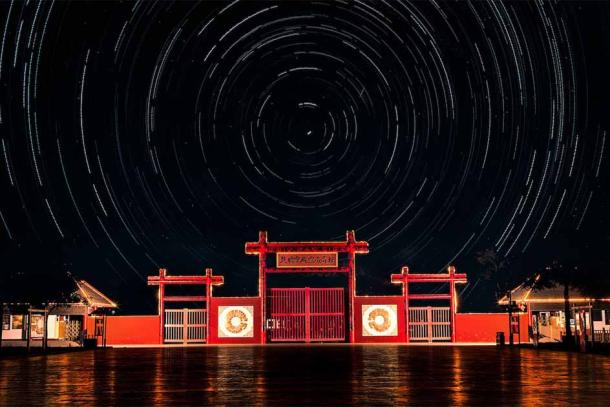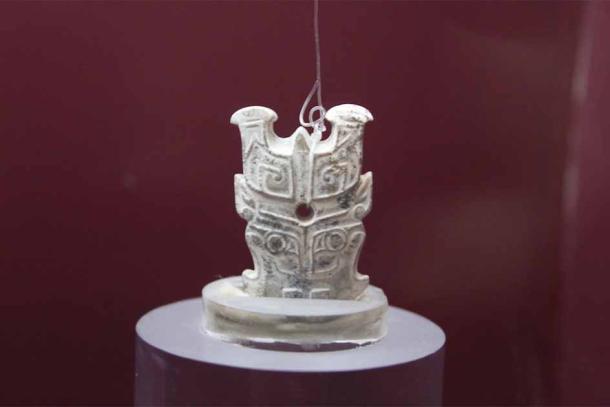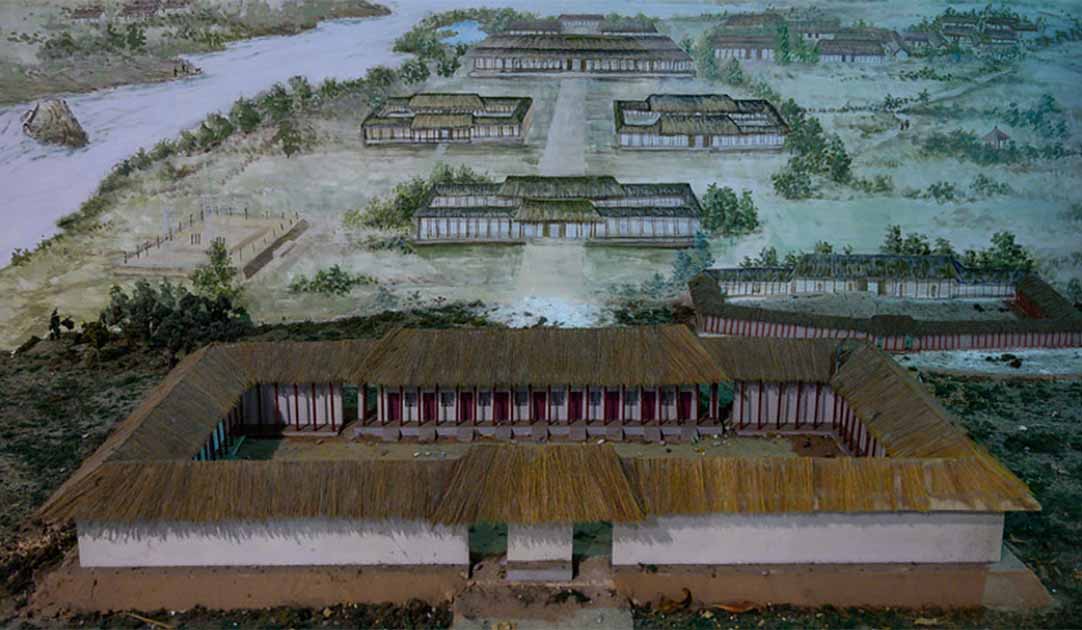Anyang: An Ancient Chinese City and the Evolution of Urbanization
Anyang has garnered recognition as a significant ceremonial and administrative hub of the Shang state. But Anyang also boasts a plethora of archaeological evidence that unequivocally substantiates the genesis of urbanism in ancient China, making it a key archaeological site for understanding the evolution of early Chinese civilization. This study examines the fascinating world of Anyang, where the layers of history have been meticulously unraveled, revealing a vivid sequence of cultural evolution. From humble village farming to the bustling urban life of the Shang Dynasty, Anyang's story is one of transformation and enlightenment.
Excavations at Anyang Reveal Evolution of Ancient China
A full and illuminating sequence of cultural history has been revealed via diligent excavations at Anyang, illustrating the rise from basic village farming to the creation of an indisputable example of Shang urbanization. Archaeological excavations at Anyang have yielded a priceless and comprehensive stratigraphical sequence, spanning from the Lungshanoid to the Shang periods. This comprehensive record vividly illustrates the direct and seamless transition from Neolithic civilizations to the highly developed city of the Shang Dynasty.
These excavations at Anyang, located in Henan Province in eastern China, have uncovered many architectural relics, most notably the regal burial site at Hsi-pei Kang, which offers a powerful witness to the rich socioeconomic institutions that once flourished in this ancient metropolis. Furthermore, the site has provided an astonishing abundance of over 100,000 engraved oracle bones, permitting a comprehensive understanding of the various facets of Shang civilization, including religious rituals and the governing structure that was in existence.

Chariot and horse burial on display at the Yin (or Yinxu) site in Anyang, China. (xiquinhosilva /CC BY 2.0)
Anyang's urban structure, with its perfectly constructed ceremonial center, bears witness to the astonishing degree of intellect and organization that pervaded its societal fabric. The site's importance goes beyond its archaeological worth; it has also served as a virtual training ground for Chinese archaeologists, fostering their expertise and increasing their understanding of the Shang Dynasty. Thus, it is certain that Anyang, with its rich and complex historical tapestry, has played a crucial role in maintaining the Shang Dynasty's historicity and cultural grandeur.

The entrance to the Yin (or Yinxu) ruins in Anyang, one of China’s oldest archeological sites. (Wirestock / Adobe Stock)
From Humble Beginnings to the Regal City of Yin
Anyang is the contemporary designation for the captivating remains of Yin, the monumental capital city of the late Shang Dynasty (1554-1045 BC). While the remains are commonly referred to as Anyang in English-language scholarly literature, the Shang Dynasty locals knew it as Yin.
Yin originated as a small residential community on the southern bank of the Huan River, a tributary of the Yellow River that runs across central China. On the other side of the river, there was another village called Huanbei (also known as Huayuanzhuang) at the time. A Middle Shang village, construction at Huanbei began around 1350 BC and eventually expanded to occupy an astounding 4.7 sq km (1.8 sq km) encircled by a rectangular wall. In 1250 BC, Wu Ding, the 21st emperor of the legendary Shang Dynasty (reigning from 1250 to 1192 BC), declared Yin as his capital.
- Unique Bronze Age Clan Cemetery Excavated in Anyang, China
- Sinister Secret of the Shang Dynasty: Its Penchant for Human Sacrifice
Yin grew into a large metropolitan city in under two centuries, with an estimated population of between 50,000 to 150,000 people. Over 100 foundations of palaces built with pounded earth have been identified among the remains, as well as various residential sections, workshops, production areas and necropolises.
Like most Bronze Age towns in China, Yin was a regal city, precisely built and erected under the king's patronage to serve as the focal point for political and religious undertakings. A regal burial site and a temple-palace complex were central to its design. As the lineage's head, the monarch was tasked with the job of presiding over rites, including venerating his ancient forefathers and preserving links with the living members of his clan.
Given its advantageous location, Anyang evolved as a vital node within the Shang Dynasty's metropolitan network. Furthermore, the city's location most likely reduced the number of entry points, enhancing its defensibility and cementing its status as an important stronghold.

The Houmuwu ding is a bronze sacrificial vessel—used for cooking, storage and ritual offerings—made by the Shang Dynasty. It was unearthed near Tinxu in Anyang. (Public domain)
Expansion and Settlement Patterns in Anyang
There was clearly a significant rise in population in the Anyang region, and this expansion was followed by a noticeable shift in the manner towns were built. Population pressure was a primary driving force in the expansion process, eventually culminating in the division of the original settlements into smaller clusters.
These clusters subsequently began colonizing rich regions located in the interstitial and periphery zones surrounding the center nucleus. This dynamic occurrence clearly suggests that Anyang's population was really rising, forcing the development of additional villages to accommodate the increasing number of individuals.
Anyang's towns were distinguished by a particular pattern of discontinuous yet repeated tenancy. It's worth noting that some of the farmers even elected to move their homes on a regular basis in conjunction with the rotation of their fields, which followed a deliberately repeating pattern. This practice demonstrates that Anyang's settlement patterns were adaptive and sensitive to the changing requirements and demands of the growing population. Furthermore, the move from shifting to permanent farming in Lung-shan village life confirms the concept of population expansion and the resulting alteration in settlement patterns.
Delving further into the features of the Anyang villages reveals that they were made up of a core ceremonial and administrative enclave that occupied a conspicuous site. This core section was most likely populated by members of royal lineages, priests and selected craftspeople. The bulk of peasants and artisans, on the other hand, lived in dispersed villages that ringed the ceremonial center. This structure suggests a hierarchical settlement plan, with the central region reserved for the aristocratic classes and the outlying towns providing necessary supplies for the ceremonial center's sustenance.
The peasantry and the majority of craftsmen who provided nourishment and ceremonial artifacts lived in the neighboring communities. These settlements were critical in producing agricultural goods to suit the demands of the ceremonial center's populace. Additionally, artists in the villages specialized in the creation of ceremonial furniture and other sacred objects. The major role of the peasants was to provide a continuous supply of resources for the central enclave.
Factors Behind the Growth of Anyang
Anyang's growth was largely fueled by different economic reasons centered on commercial activity and the dynamics of urban society. During the fifth century, a unique class of urban merchants arose, using their collected riches to wield enormous political power within society. These savvy merchants carefully put their excess riches in land, so reinforcing class hierarchies and disparities.
Notably, this economic issue resulted in the formation of a landless peasants, further changing Anyang's socioeconomic environment. At the same time, the growth of commercial activity inside the urban framework was causing a similar transition. The rising affluence of these urban merchants allowed their capacity to invest in land, playing a vital part in the socioeconomic transformation that was taking place.
A growing volume of evidence suggests that craft production and specialization for market exchange played an important role in the progress of urbanization in Yinxu's capital city, Anyang. Similarly, the urban economy was strongly reliant on the specialized manufacturing of bone tools and jade jue earrings.
The Shang monarchs organized a profound economic shift that drastically transformed the cultural environment, driven by their desire to increase economic growth. This historic transition was principally accomplished by allocative pressures coming from the ceremonial center, which created appropriational movements oriented primarily towards itself before extending outwards.
This watershed moment at Anyang signaled a change from the previously dominant ideal-type system of reciprocity, paving the way for a more centralized and redistributive economic system guided by the Shang monarchs. Furthermore, the Shang rulers' distribution of authority, as well as the giving of benefices for services given, most likely functioned as an extra stimulant for economic activity inside the community.
The Shang Dynasty developed a centralized patrimonial state, wielding ultimate power over its citizens via a blend of traditionalism and arbitrariness. The oracle archives show this governance arrangement. Military conquest and alliances were used to expand territory, demonstrating a reliance on concentrated control. According to some researchers, the Shang kingdom was a theocracy, with the monarch serving as a supreme lord and religious leader. These political forces, together with economic rearrangement, most certainly contributed to Anyang's rise as a major urban center in Shang China.
The Shang dynasty's social stratification played a critical role in power consolidation, facilitating urban planning and development. Kinship relationships among the top class were crucial in structuring and legitimizing the complex social structure inside the urban setting.
Furthermore, the emergence of specialized positions, such as artisans and officials, considerably aided the rise of urban economies and institutions. These responsibilities not only aided in the development of urban centers, but also in the growth of numerous sectors inside these cities.
The contrast between aristocratic and commoner homes was one noticeable manifestation of the urban hierarchy, which not only represented the existing social classes but also perpetuated this hierarchical structure within the urban context. It is clear that the Shang Dynasty's social dynamics and structure had a significant impact on the urban landscape, determining its growth and preserving the urban hierarchy.
The Shang Dynasty's pyramidal society, commanded by the monarch and royal lineages, established a concentrated power structure that provided control over resources and government. This social hierarchy centralized authority at society's apex and provided control over different facets of government and resources.

Shang jade pendant excavated at the Yin ruins in Anyang. (Public domain)
Unique Features and Specifications of Anyang
Anyang is famous for the discovery of oracle bones, which are the oldest known written reports in China. These bones were used for divination and provide credible evidence of the existence of ancient Chinese civilization.
Investigations have discovered solid evidence of the region's widespread adoption of Shang urbanization. This evidence comprises a massive earthen wall enclosing a rectangular, allegedly ceremonial area.
Furthermore, the varying treatment of people from different social classes in matters of death adds to Anyang's historical and cultural relevance. The vast differences in grave goods and burial practices seen between lower-class peasants and the aristocracy give vital insights on the time's hierarchical structure and prevalent customs. These differences serve as a devastating reminder of the Anyang society's socioeconomic division, underscoring the deep-rooted injustices that infiltrated the fabric of this ancient civilization.
The use of the hang-t'u technique, also known as stamped earth, was a common building practice in ancient China. This method involved hammering and compacting dirt to form walls and foundations for constructions. The use of the hang-t'u foundation in residential zones, ancestor temples and ceremonial places attests to its ongoing importance and prominence in ancient Chinese architectural techniques.
Human sacrifice served several purposes in Anyang. It was utilized for building construction and was devoted to the kings' funeral worship. The meaning of this cult to the general public is unknown, although it might have been a political tool. The amount of sacrifice observed at Anyang was most likely necessitated by divine belief. The tradition of sacrificing nameless victims in burial ceremonies, however, stopped with Duke Xian of Qin in 384 BC, and even the remembrance of these killings was lost. The successive Western Zhou Shang monarchs were accused of intoxication rather than killing.

A pit containing oracle bones discovered at Yin (or Yinxu) in Anyang, China. Oracle bones are inscribed pieces of bone of turtle plastron which contained important information and date back to the Shang Dynasty. (Xuan Che / CC BY 2.0)
Archaeological Findings Uncovered at Anyang
The excavations conducted at Anyang have brought forth a vast amount of valuable knowledge regarding the city and its inhabitants.
· Significant Architectural Foundations: The excavations at Anyang have revealed substantial pounded-earth ( hangtu) architectural foundations. These foundations were utilized to provide structural support for the city's buildings. The presence of such large pounded-earth architectural foundations suggests a well-organized and meticulously planned urban environment.
· Impressive Burial Structures: The excavations at Anyang have also unearthed immense shaft tombs. These tombs served as the final resting place for the esteemed members of society. The existence of sacrificial burial cemeteries and these colossal shaft tombs implies that the Shang Dynasty possessed a complex religious system and adhered to a hierarchical social structure.
- The Shang Dynasty: Second in Traditional Historiography, First in Archaeology
- Reading Oracle Bones and Writing the Future in the Shang Dynasty
· Bronze Artifacts: Furthermore, the excavations at Anyang have unveiled caches of bronze vessels. These vessels held significant importance in various rituals and frequently featured inscriptions containing crucial information about the Shang Dynasty. The presence of these caches of bronze vessels indicates that the Shang Dynasty had an intricate system of writing and meticulous record-keeping.
· The Discovery of Oracle Bones: Oracle bones were initially identified for their true nature in 1898, and scholars have since dedicated their efforts to deciphering them. These oracle bones circulated among collectors and antique dealers, and to this day, approximately 200,000 fragments of oracle bones from the Xiaotun site in Anyang have been meticulously tallied and documented.

The Yin (or Yinxu) site is especially known for its oracle bones, whose carvings are the oldest known examples of Chinese writing. (Public domain)
Perspectives on Anyang: Insights from Historians and Archaeologists
· David N. Keightley: An American historian of great repute, who has devoted considerable attention to the Shang Dynasty, opines that the oracle bones unearthed at Anyang offer significant insights into the political, social, and religious customs prevalent during the Shang dynasty.
· Robert Bagley: An esteemed art historian from America renowned for his comprehensive investigations into the Shang Dynasty. It is his conviction that the city of Anyang was a meticulously designed urban hub boasting a organized arrangement and an advanced system for the disposal of wastewater.
· Jessica Rawson: An archaeologist hailing from the United Kingdom, who has dedicated significant efforts to investigating the Shang Dynasty. Rawson posits that the metropolis of Anyang held a prominent position as a flourishing urban hub, accommodating a substantial populace actively involved in diverse artisanal and commercial pursuits.
· Chang Kwang-chih: A Taiwanese archaeologist, has dedicated his scholarly pursuits to an extensive exploration of the Shang Dynasty. His assertions posit that the intricate urban realm of Anyang encompassed a multifaceted populace, consisting of individuals from diverse social strata and economic circumstances.

Archaeologists during excavations at YH127 pit in Yinxu, Anyang, in 1936. (Public domain)
Anyang's Legacy: Lessons Learned from its Archaeological Record
Anyang, as a pivotal hub of the Shang Dynasty, stood as a testament to a sophisticated sociopolitical structure. The visionary leadership within the city symbolized wealth and prosperity, particularly evident in the flourishing iron-smelting and salt manufacturing industries.
Agriculture was central to the Shang Empire, prioritized ceremonial interventions to secure a sustained food supply, with the monarchs paying close attention to agricultural success and pursuing secure and sustained food supply by ceremonial interventions. Technological advancements, exemplified by innovations like the iron-sickle, coupled with organized agricultural labor and store management, unveiled a society marked by progress and economic order.
In essence, Anyang emerges as a crucial cultural nexus throughout the Shang Dynasty, offering profound insights into ancient Chinese culture through its intricate sociological, political and economic institutions. Archaeological evidence from Anyang provides much-needed clues to understanding the birth of urbanism in ancient China, solidifying Anyang's significance as a cornerstone archaeological site for unraveling the evolutionary tapestry of early Chinese civilization.
Top image: Representation of ancient Anyang city, Henan, China. Source: xinquinosilva/CC BY 2.0 Deed
By Ardent Geroy
References
Bagley, R. 2009. “Anyang Mold-Making and the Decorated Model” in Artibus Asiae 69, no. 1.
Campbell, R. B. et. al. 21 November 2011. “Consumption, exchange and production at the Great Settlement Shang: bone-working at Tiesanlu, Anyang” in Antiquity 85(330): pp. 1279-1297. Available at: https://doi.org/10.1017/S0003598X00062050
Chang, K.-C. 1968 “Archeology of Ancient China” in Science, vol. 162, no. 3853. Available at: https://doi.org/10.1126/science.162.3853.519
Childe, V. G. 1950. “The Urban Revolution” in The Town Planning Review, Vol. 21, No. 1
Childs-Johnson, E. (ed.) 2020. The Oxford Handbook of Early China.
Eberhard, W. 1960. A History of China. Second edition. University of California Press, Berkeley and Los Angeles.
Flad, R. 2018. “Urbanism as technology in early China” in Archaeological Research in Asia, Volume 14, pp. 121-134. Available at: https://doi.org/10.1016/j.ara.2016.09.001
Keightley, D. N. 1983. The Origins of Chinese Civilization. University of California Press,
Kotkin J. 2005. The city: a global history.
Mumford, L. 1961. The City in History: Its Origins, Its Transformations, and Its Prospects. New York: Harcourt, Brace and World.
Loewe, M., & Shaughnessy, E. 1999. The Cambridge History of Ancient China: From the Origins of Civilization to 221 BC. Cambridge: Cambridge University Press
Rawson, J. 1980. Ancient China, Art and Archaeology.
Wheatley, P. 1971. The Origins and Character of the Ancient Chinese City: Volume 1, The City in Ancient China (1st ed.). Routledge.

















